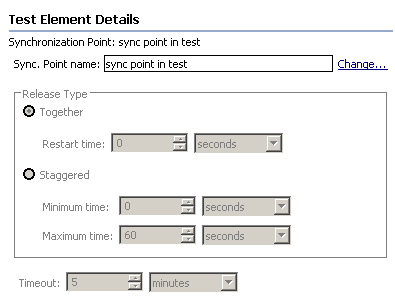Synchronize users in tests
Overview
Inserting a synchronization point enables you to coordinate the activities of a number of virtual users by pausing and resuming activities.
You can synchronize all virtual users at the beginning of a test and stagger the release times so that the users do not overload the system. Synchronization points are also useful in stress testing.
You can insert a synchronization point into a schedule or a test.
You typically insert synchronization points into schedules, because they are more visible at the schedule level and you can set the Release and Timeout options within a schedule only, not within a test.
You should insert a synchronization point into a test in the following cases:
- You want to control where the synchronization point appears.
For example, you can insert a synchronization point just before a test sends a request to a server.
- You have edited a test, and the execution of a synchronization point depends on the logic that you have added.
Synchronization points within loops are not reset. In other words, once a synchronization point has been released (in the first iteration of a loop) it stays released for all further iterations.
Insert a synchronization point into a test
- Double-click a test
- Click the test element just below the place to add
the synchronization point, and then click...
-
Insert | Synchronization point
Depending on the nature of the test element, you can insert a synchronization point at some points in the test hierarchy, but not at others.
- Type a name for the synchronization point, or select the name of an existing synchronization point.
The synchronization point opens in the test. Note that you cannot change the Release Type or Timeout within the test.

-
To change the Release Type or Timeout, open the synchronization point within a schedule and make the changes.
The changes affect all instances of the synchronization point.